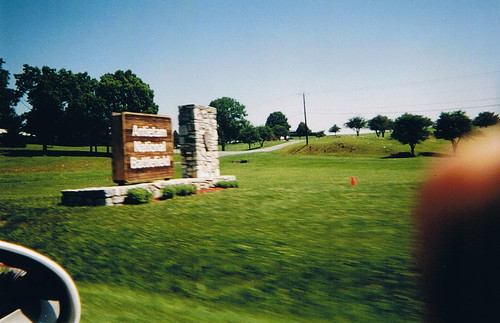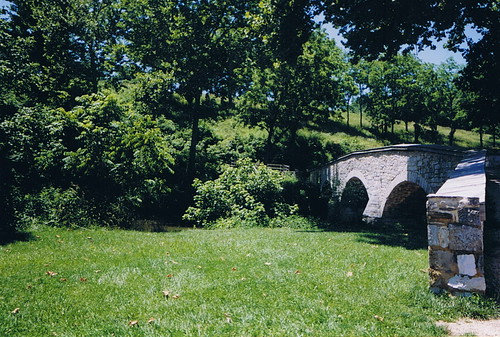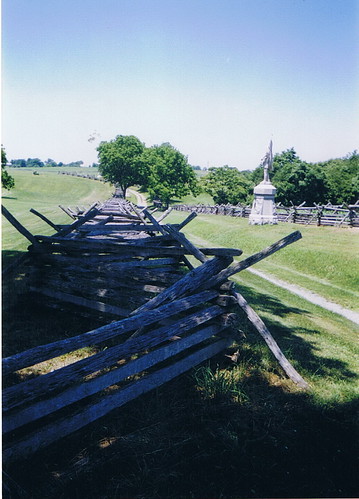It was a sunny day, 150 years ago last Monday that the Union and Confederate armies met outside a place called Sharpsburg, Maryland. You might know it as Antietam. During this one-day battle, 23,000 men were either killed or wounded, the bloodiest day in U.S. history. Ironically, the 17th of September is also Constitution Day. The Civil War threatened to shake that constitution apart. The men who fought, lived and died here probably didn't know what significance the date was, and perhaps, at the time, very few others did.
In June of 2001, after Carole graduated from Wheaton North high school, the two of us rented a car and took a tour of various Civil War battlefields. Our first stop was Gettysburg. Our second stop was Antietam.
I remember the battlefield as being hard to get to, not like Gettysburg at all. I remember driving around curving roads and past the memorial cemetery, into a part of Sharpsburg which seemed to look, except for a highway, much like it must have looked in 1862.
I don't remember the visitor center. I remember the asphalt road that took you into the battlefields, to the locations, such as Dunker Church, above. The road was one-way, the better to preserve the area. I don't remember going into the church, but I'm sure we must have.
The drive circles through the park, which was, at the time we were there, two separate areas, joined by a thin strip of land.
This view looks back at the park buildings and the New York Monument.
There are many places to get out and look. Probably the biggest "attraction" if you will, is the sunken road or "bloody lane", as it came to be known. The Union attacked the Confederate, charging out of a cornfield and straight at the road. As this was June, the corn, which the park service dutifully plants in the same field every year, was only knee high. On that September day, it was about a month off harvest so it was over a head in height.
The Union attack came from the right. (The lane is not north south. It's on a diagonal from SE to NW.) This was, at the time of the battle, a two wheel rutted track used mainly by farmers. But it was sunken enough that men charging from the right would not be able to see how many were hunkered down in the road just waiting.
There is a brick observation tower at the south end of the road. It wasn't handicap accessible when we were there and it's about 3 stories tall. I remember climbing the inside, the metal stairs. It was warm inside the tower, but, when you got to the top, the view was worth the climb.
It's difficult, for me, to imagine the mindset of the soldier, either lying in wait in the lane or preparing to charge through head-high corn towards this little piece of ground. The Union soldiers burst through the corn. The Confederate men waited until they were within 4 feet, then stood up and fired. Whole squads were obliterated in minutes. In 4 hours of fighting, 5,000 men died here, just here. There were so many casualties in the road that, at the end of the battle, it was said you could walk from the tower to those trees in the distance without ever touching ground.
It's sobering to walk the road now. When we visited, there weren't many people at the battlefield. I would imagine September is the busy month and, over the weekend past, a reenactment of the battle was held over three days. Although it was afternoon when we got here, we had the chance to take our time, to walk about, to just be in the places where people fought and died.
We ended the tour at Burnside Bridge. In reading and listening to the stories about the battle, I could not remember visiting the bridge. We had to; no tour would be complete without stopping there; but as much as I remember looking out over the battlefield from the tower, passing by Dunker church and pausing amongst the trees where Lee's camp was, I don't remember the bridge. In looking through our photos, here it is.
General Ambrose Burnside and his men spent all afternoon trying to go from the point the photo is taken, across the bridge and up the far hillside. The Georgia militia held them off until Burnside was reinforced and sheer numbers overwhelmed them. It is said the creek was red with blood. The bridge was named for Burnside's attack. We walked across it, hearing only the sound of Antietam Creek below us. It's a lovely bridge.
The battle was, essentially, a stalemate. No ground was gained or lost. Lee retreated and General George McClelland chose not to purse him. That decision resulted in one of Lincoln's best quotes, written in a letter to McClelland. "My dear General McClelland, If you are not using the army, I should like to borrow it for a short while. Yours respectfully, A. Lincoln." But McClelland's inaction here was the final straw which resulted in his being fired by Lincoln.
Alexander Gardner, one of Matthew Brady's employees, came to the battlefield two days after the fighting. His images are the ones we recall, the bodies in front of Dunker Church and still lying in the sunken road. It took four days to find and bury all the bodies, four days.
I liked Antietam better than Gettysburg. There are so many monuments to divisions, regiments, battalions and points of battle at Gettysburg that it can be hard to imagine what the men experienced. Antietam has its monuments, such as the one above, but they aren't all over. It's a beautiful place and beautifully preserved.
Beverage: English Breakfast tea
Deb






No comments:
Post a Comment